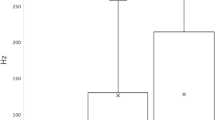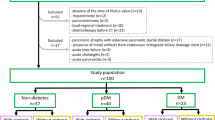Abstract
Purpose
To evaluate pancreatic T1 mapping and extracellular volume (ECV) fraction’s feasibility to assess impaired glucose tolerance (IGT) patients.
Methods
A total of 45 consecutive patients with known or suspected pancreatic disease underwent contrast-enhanced magnetic resonance (MR) imaging, including T1 mapping, using saturation recovery sequence. Patients were classified into three groups based on the American Diabetes Association criteria: no-diabetes subjects, HbA1c < 5.7%; pre-diabetes, 5.7% ≤ HbA1c < 6.5%; and type 2 diabetes mellitus (T2DM), HbA1c ≥ 6.5%. Pre-contrast pancreatic T1 value and ECV of the pancreas were computed, and then pre-contrast pancreatic T1 value, ECV and HbA1c values were compared. The present prospective study was approved by our institutional review board. Written informed consent was obtained from all patients.
Results
A positive correlation between HbA1c values and both pre-contrast pancreatic T1 value and ECV (r = 0.79, P < 0.001 and r = 0.60, P < 0.001, respectively) were observed. The pre-contrast pancreatic T1 value and ECV were significantly higher in T2DM vs. no-diabetes subjects and pre-diabetes (P < 0.001). No significant difference between two qualitative values (P = 0.14) was found, however, the sensitivity, specificity, and area under the receiver-operating-characteristic curve differentiating no-diabetes subjects and pre-diabetes from T2DM were superior in ECV (100%, 93.5%, and 0.990) vs. pre-contrast pancreatic T1 values (84.6%, 96.8%, and 0.906).
Conclusions
The ECV of the pancreas could serve as a potential imaging biomarker for the assessment of pancreatic fibrosis leading to IGT.





Similar content being viewed by others
References
Clark A, Wells CA, Buley ID, et al. Islet amyloid, increased A-cells, reduced B-cells and exocrine fibrosis: quantitative changes in the pancreas in type 2 diabetes. Diabetes Res 1988; 9:151-159Clark A, Wells CA, Buley ID, et al. Islet amyloid, increased A-cells, reduced B-cells and exocrine fibrosis: quantitative changes in the pancreas in type 2 diabetes. Diabetes Res 1988; 9:151-159
Noda Y, Goshima S, Tanaka K, et al. Findings in pancreatic MRI associated with pancreatic fibrosis and HbA1c values. J Magn Reson Imaging 2016; 43:680-687
Fitts M, Breton E, Kholmovski EG, et al. Arrhythmia insensitive rapid cardiac T1 mapping pulse sequence. Magn Reson Med 2013; 70:1274-1282
Tirkes T, Lin C, Fogel EL, Sherman SS, Wang Q, Sandrasegaran K. T1 mapping for diagnosis of mild chronic pancreatitis. J Magn Reson Imaging 2017; 45:1171-1176
Noda Y, Goshima S, Tsuji Y, et al. Correlation of quantitative pancreatic T1 value and HbA1c value in subjects with normal and impaired glucose tolerance. J Magn Reson Imaging 2019; 49:711-718
Luetkens JA, Homsi R, Sprinkart AM, et al. Incremental value of quantitative CMR including parametric mapping for the diagnosis of acute myocarditis. Eur Heart J Cardiovasc Imaging 2016; 17:154-161
Flett AS, Hayward MP, Ashworth MT, et al. Equilibrium contrast cardiovascular magnetic resonance for the measurement of diffuse myocardial fibrosis: preliminary validation in humans. Circulation 2010; 122:138-144
Luetkens JA, Klein S, Traber F, et al. Quantification of Liver Fibrosis at T1 and T2 Mapping with Extracellular Volume Fraction MRI: Preclinical Results. Radiology 2018; 288:748-754
American Diabetes A. 2. Classification and Diagnosis of Diabetes: Standards of Medical Care in Diabetes-2018. Diabetes Care 2018; 41:S13-S27
Morita K, Oda S, Utsunomiya D, et al. Saturation Recovery Myocardial T1 Mapping with a Composite Radiofrequency Pulse on a 3T MR Imaging System. Magn Reson Med Sci 2018; 17:35-41
Kim PK, Hong YJ, Im DJ, et al. Myocardial T1 and T2 Mapping: Techniques and Clinical Applications. Korean J Radiol 2017; 18:113-131
Kise Y, Chikui T, Yamashita Y, Kobayashi K, Yoshiura K. Clinical usefulness of the mDIXON Quant the method for estimation of the salivary gland fat fraction: comparison with MR spectroscopy. Br J Radiol 2017; 90:20160704
Schelbert EB, Messroghli DR. State of the Art: Clinical Applications of Cardiac T1 Mapping. Radiology 2016; 278:658-676
Hanley JA, McNeil BJ. A method of comparing the areas under receiver operating characteristic curves derived from the same cases. Radiology 1983; 148:839-843
Cui Y, Cao Y, Song J, et al. Association between myocardial extracellular volume and strain analysis through cardiovascular magnetic resonance with histological myocardial fibrosis in patients awaiting heart transplantation. J Cardiovasc Magn Reson 2018; 20:25
Xin A, Mizukami H, Inaba W, Yoshida T, Takeuchi YK, Yagihashi S. Pancreas Atrophy and Islet Amyloid Deposition in Patients With Elderly-Onset Type 2 Diabetes. J Clin Endocrinol Metab 2017; 102:3162-3171
Winston CB, Mitchell DG, Outwater EK, Ehrlich SM. Pancreatic signal intensity on T1-weighted fat saturation MR images: clinical correlation. J Magn Reson Imaging 1995; 5:267-271
Rathmann W, Haastert B, Oscarsson J, Berglind N, Wareham NJ. Inverse association of HbA1c with faecal elastase 1 in people without diabetes. Pancreatology 2015; 15:620-625
Loser C, Mollgaard A, Folsch UR. Faecal elastase 1: a novel, highly sensitive, and specific tubeless pancreatic function test. Gut 1996; 39:580-586
Fukukura Y, Kumagae Y, Higashi R, et al. Estimation of Extracellular Volume Fraction With Routine Multiphasic Pancreatic Computed Tomography to Predict the Survival of Patients With Stage IV Pancreatic Ductal Adenocarcinoma. Pancreas 2019; 48:1360-1366
Tirkes T, Mitchell JR, Li L, Zhao X, Lin C. Normal T1 relaxometry and extracellular volume of the pancreas in subjects with no pancreas disease: correlation with age and gender. Abdom Radiol (NY) 2019; 44:3133-3138
International Expert C. International Expert Committee report on the role of the A1C assay in the diagnosis of diabetes. Diabetes Care 2009; 32:1327-1334
Dorcely B, Katz K, Jagannathan R, et al. Novel biomarkers for prediabetes, diabetes, and associated complications. Diabetes Metab Syndr Obes 2017; 10:345-361
Author information
Authors and Affiliations
Corresponding author
Ethics declarations
Conflict of interest
All authors declare that they have no conflicts of interest to disclose.
Research involving human participants and/or animals
All procedures performed in studies involving human participants were in accordance with the ethical standards of the institutional and/or national research committee and with the 1964 Helsinki declaration and its later amendments or comparable ethical standards. This prospective study was approved by our Institutional Review Board, and a written informed consent was obtained from all patients.
Informed consent
The requirement for informed consent was obtained from all patients.
Additional information
Publisher's Note
Springer Nature remains neutral with regard to jurisdictional claims in published maps and institutional affiliations.
Rights and permissions
About this article
Cite this article
Noda, Y., Goshima, S., Tsuji, Y. et al. Pancreatic extracellular volume fraction using T1 mapping in patients with impaired glucose intolerance. Abdom Radiol 45, 449–456 (2020). https://doi.org/10.1007/s00261-019-02384-7
Published:
Issue Date:
DOI: https://doi.org/10.1007/s00261-019-02384-7




